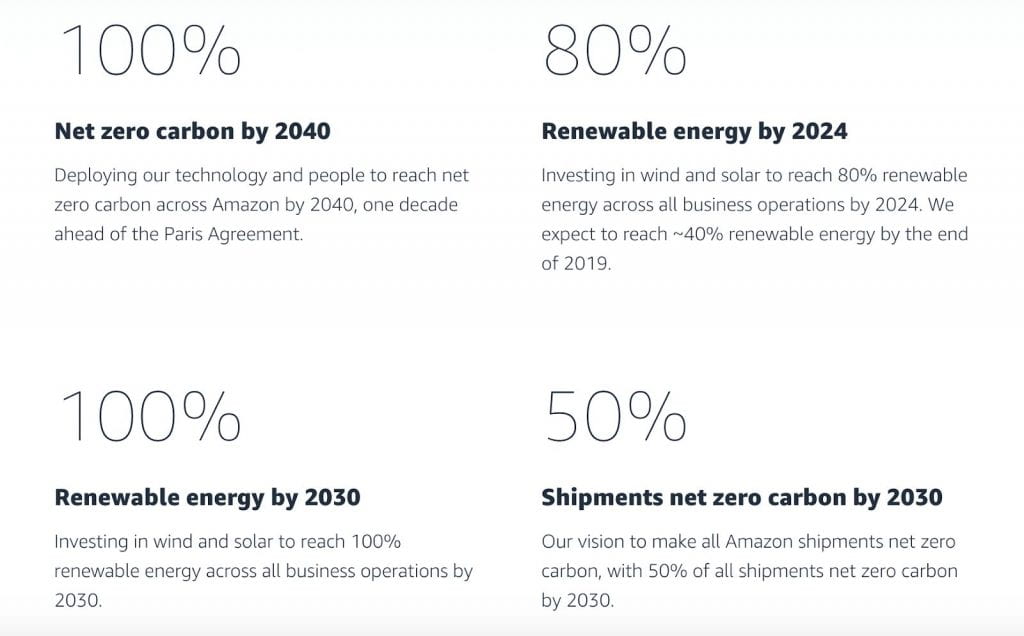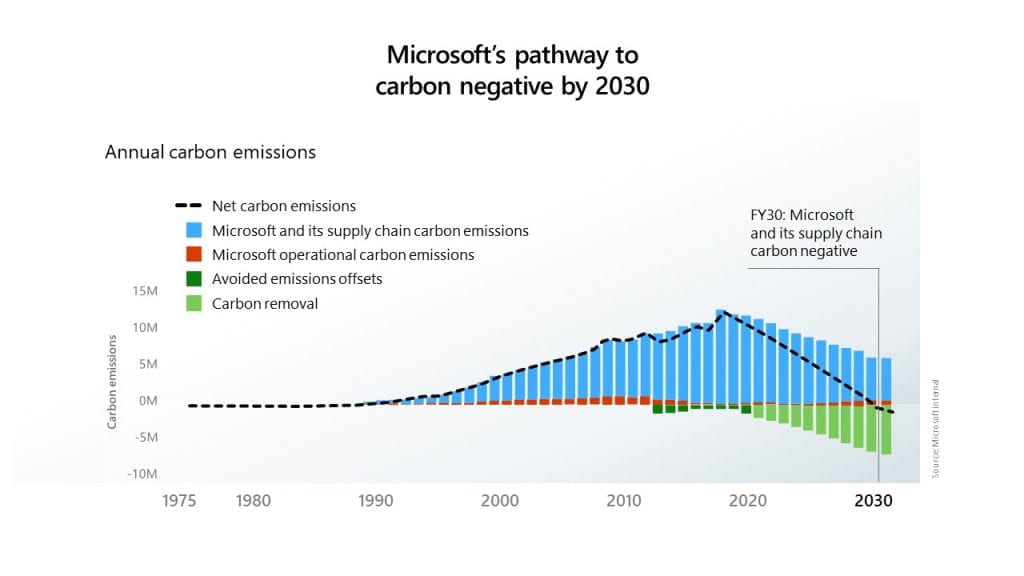By Laura Walk and Lauren Archer
—————
In January 2020, BlackRock CEO Larry Fink surprised the world with his famous letter stating that climate change will the single most important factor to reshape finance. Companies will have to shift sustainability from an afterthought to a priority.
Many are stepping up to the challenge. More and more companies, especially those among the world’s largest and most prominent, are committing to climate action. In January, Microsoft announced that it will be going “carbon negative”, removing all of the carbon the company has emitted either directly or by electrical consumption since it was founded in 1975. A few weeks later, Amazon CEO Jeff Bezos pledged to donate $10 billion of his own money to scientists, activists and nongovernmental organizations working to fix the climate crisis. Other companies, like Delta Airlines, pledged to go carbon neutral via the purchase of hundreds of millions of dollars in carbon offsets.
With an increasing number of companies making headlines with their actions, it’s difficult to get a sense of the scope of climate action in the corporate world, and see how these actions stack up against one another.
—————
This project attempts to sift through the noise and help consumers make sense of the current Corporate Climate Action Landscape. We examine the Fortune Global 500 to get a sense of what fraction of companies have taken action, and what exactly these actions mean.
Hit the black right arrow to examine the climate actions of Fortune Global 500. After seeing how we broke down the data; you can group, shade, and size the data yourself on any slide using the box on the bottom right.
————————-
Now let’s take a deeper look into a single industry – technology – and examine two specific corporate climate plans: Amazon and Microsoft.
Technology has a fundamental role in addressing climate change and promoting sustainable behaviors amongst consumers. As these corporations continue to grow revenue exponentially, engulf smaller companies, and reshape market structure, they leave a carbon emissions trail. The tech industry has faced substantial criticism for the significant energy used to power its computing infrastructure and cloud services. According to a 2019 report, the industry’s “2020 footprint will be as high as 3.6% of global greenhouse gas emissions, more than double what the sector produced in 2007.”
Amazon has grown its revenue and market dominance especially considerably throughout the last decade. While Microsoft has set a precedent with its carbon negative goal, Amazon is focusing more on carbon offsets and achieving carbon neutrality. Amazon’s behemoth size makes achieving more aggressive goals significantly harder, Amazon can and should do more now. Only recently after employee protests and bad press has Amazon stepped up to the plate. They just released carbon emissions data for the first time two years ago and are moving towards more transparency little by little. It seems that their movements toward sustainability are motivated by image and corporate social responsibility trends.
Public sentiment and consumer perception are powerful motivators for companies to actually make changes. Although it is a larger company than Microsoft, which makes reducing carbon emissions across different levels of the production process more difficult, Amazon can do more. Companies must realize that climate sustainability is not just a corporate social responsibility issue, it is a business issue as well. As climate change continues, environmental barriers will make producing, shipping, and transporting goods and services more costly in the future.
—————
Let’s take a look at how Amazon and Microsoft are approaching climate sustainability:
Amazon’s “Climate Pledge”
Amazon has taken a passive stance on climate sustainability and carbon emissions reductions. The company has refused to participate in increasingly common corporate social responsibility and environmental disclosures. 2019 was the first year that Amazon released its emissions data to the public, largely due to escalating pressures from employees and shareholders. Along with this disclosure, in September 2019, Jeff Bezos unveiled a new corporate “Climate Pledge.”

Amazon’s Goals:
- By 2024, 80% of energy from renewable energy sources
- By 2030, 100% renewable energy
- By 2040, net zero carbon emissions
- Other: induction of 100,000 electric vehicles into the delivery fleet, a $100 million investment in reforestation projects, and a website to track and report on these commitments
Beyond these commitments, Amazon remains vague on the feasibility and details of the plan. While Amazon publicizes its use of “green energy” and purchase of wind and solar farms to paint a positive image of sustainability, its efforts greatly undershoot the total negative environmental impact accompanied by its exponential growth. Amazon’s proposals of a fully electric fleet and investment in reforestation projects do not have a specific timeline attached to them nor a specific plan of implementation either. Perhaps the area of most concern is the lack of inclusion of Scope 3 emissions in Amazon’s carbon reduction plan. Scope 3 emissions contribute to more than 75% of Amazon’s overall carbon footprint. Amazon is the least transparent of the “Big Five” tech companies about its cloud services.
Amazon Web Services (AWS) is the largest cloud service provider in the world. According to company projections made in 2015, Amazon Web Services’ electricity use was expected to triple from 2.4 million megawatt-hours to 7.2 million from 2014 to last year. That difference is nearly as much electricity as all of Seattle uses and amounts to 3.3 million tons of CO2. Although Bezos has committed to 100% renewable energy to power all of its data centers, a Greenpeace report found that Amazon’s data centers use varying percentages of renewable energy to power electricity usage (Greenpeace report). For example, some of its largest data centers are powered by only 12 percent renewable energy. With increased usage of AWS operations, many of these centers have failed to add new renewable energy to supplement this increase. Relatedly, Amazon offers machine learning and other AI technologies to oil companies like BP, Shell and others.
Amazon has taken a first step towards climate sustainability by proposing this plan, but the company will need to continue to feel pressure from competitors and consumers to actually implement the goals outlined in the “Climate Pledge” meaningfully. That Amazon has not fully committed to its goals of 100% renewable energy-powered data centers calls into question its commitment to the “Climate Pledge.”
—————
Microsoft’s “Climate Moonshot”
Microsoft has spearheaded “Big Tech’s” move toward climate sustainability with “Climate Moonshot,” an aggressive plan to take responsibility for its emissions and implement sustainable practices.

Microsoft’s Goals:
- By 2025, shift to renewable energy for its buildings and data centers that support Microsoft’s cloud service
- By 2030 Microsoft will be carbon negative
- By 2050 Microsoft will remove from the environment all the carbon it has emitted either directly or by electrical consumption since it was founded in 1975.
Microsoft has purchased enough offsets and credits (paying others to counteract its carbon pollution) to claim to be carbon neutral since 2012. Carbon neutrality is the “standard” environmental goal implemented by many companies, particularly in the technology industry, as we saw with Amazon. Microsoft is leveling up the competition standard for climate sustainability by announcing a carbon negative commitment. Being “carbon negative” means that a company must remove more carbon from the atmosphere than it emits.
A BBC article outlines the ways in which Microsoft has suggested a range of ways it could remove carbon from the atmosphere, including:
- Soil carbon sequestration – a process of putting carbon back into the ground. This could be achieved by adding microbes and nutrients to parched earth, which should have the added benefits of making the soil more fertile and less susceptible to erosion
- Direct air capture – sucking carbon dioxide out of the atmosphere, possibly by using large fans to move air through a filter that can remove the gas
- Bio-energy with carbon capture – growing crops and then capturing the CO2 they emit when, for example, they are burned to produce heat or fermented to make fuels such as bioethanol. Negative emissions become possible if the amount of CO2 stored as a result is greater than that emitted during production, transport and use
- Seeding new forests and expanding existing ones
Microsoft’s plan has been lauded by environmentalists and climate conscious employees. Instead of relying primarily on offsets to reduce its carbon footprint, Microsoft is taking strides to physically reduce emissions produced directly and indirectly by its operations. However, it is important to think about the feasibility of implementing this plan. In order to become carbon negative across all its operations, Microsoft plans to rely on new technologies that remove carbon and store it underground for long periods of time. Microsoft said it would provide $1 billion to its new Climate Innovation Fund over the next four years to back development of carbon-removal technology. However, this reliance on technology could prove disadvantageous if they are not able to launch that technology platform in the same way or as quickly as originally thought. Additionally, there is limited physical capacity to store large amounts of carbon.
Perhaps overshadowed by Microsoft’s progressive climate plan are its dealings with fossil fuel companies. In 2019, Microsoft entered into long-term partnerships with three major oil companies, including ExxonMobil, that use Microsoft’s machine-learning and AI technology to expand oil production by as much as 50,000 barrels a day over the coming years. This significant amount of carbon released by this would not be included as part of Microsoft’s total emissions.
—————
Although Microsoft has set a strong precedent for climate sustainability moving forward and Amazon has taken a first step toward holding itself accountable for its carbon emissions, there is still a long way to go. Amazon’s environmental impact could improve if the company focused more on reducing its carbon footprint, offering pick-your-own delivery date options to reduce the high environmental cost of Prime shipping, and offering consumers more information about shipping options. Additionally, Amazon can continue to outline its “Climate Pledge” in more step-by-step detail. In order for Microsoft to stay true to its “Climate Moonshot” commitment, it must analyze the feasibility of its lofty goals and be prepared to shift to alternative plans if the technology-driven plan they tout does not prove to work at full capacity.
Perhaps the most crucial step for both Amazon and Microsoft is ending contracts that indirectly support oil and gas exploration. This type of indirect emissions is not included in either company’s formal emissions data and is likely a substantial contributor to total CO2 emissions. Thus, the current total CO2 emissions shown graphically earlier likely substantially understate the true carbon footprint of both of these companies. These two tech companies hold a rapidly increasing share of the S&P 500 as consumers demand technology services more than ever. If Amazon and Microsoft use their power and influence to set a precedent for climate sustainability, consumers and other businesses are likely to follow.
—————
This project was created by Laura Walk ’20 and Lauren Archer ’20 at Dartmouth College, Environmental Studies Department.
Data for this project was sourced from Natural Capital Partners, Fortune, RE100, the Science-Based Target Initiative, Statista, Daze Info, Digital Information World, and Amazon’s and Microsoft’s Emissions Data and Sustainability Reports. Visualizations were created using Flourish.